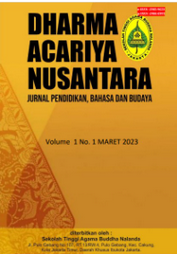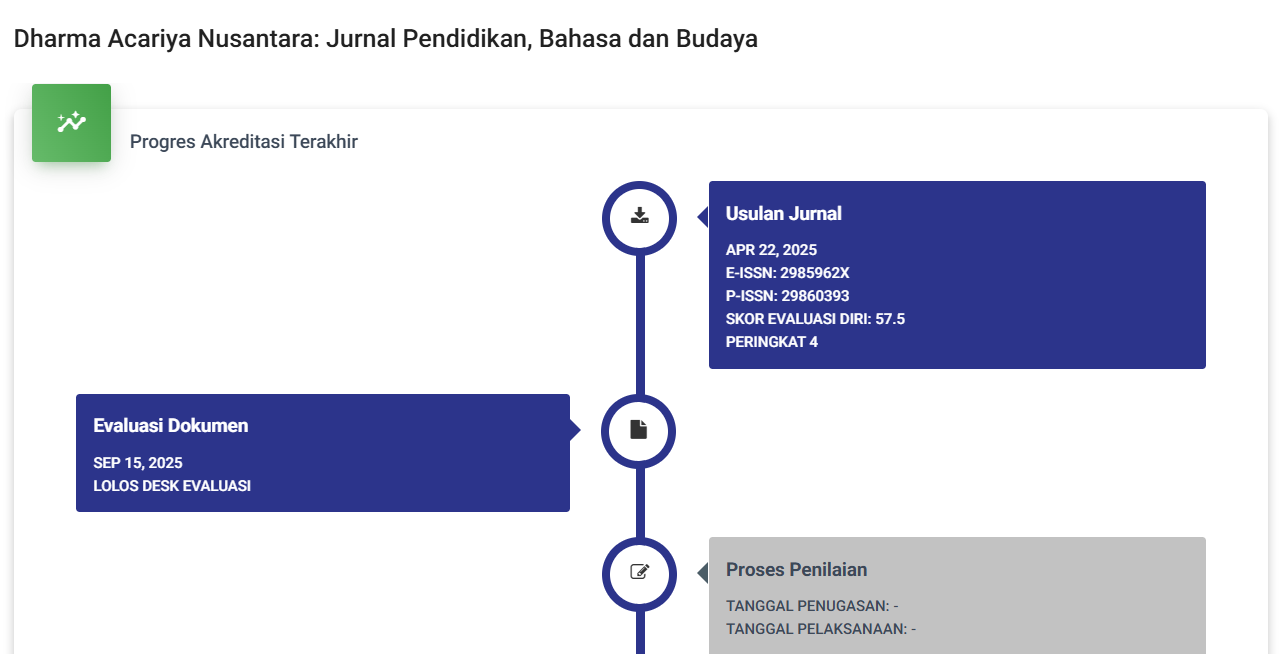Struktur Pertunjukan Tari Tor Tor Naposo Nauli Bulung dalam Acara Pesta Perkawinan di Sawah Mudik Kabupaten Pasaman Barat
DOI:
https://doi.org/10.47861/jdan.v2i1.788Keywords:
Structure, Performance, Dance Tor Tor Naposo Nauli Bulung, Wedding PartyAbstract
The purpose of this study is to reveal and describe the structure of Tor Tor Naposo Nauli Bulung dance performance at a wedding ceremony in Sawah Mudik, West Pasaman Regency. This type of research is qualitative research with descriptive methods. The researcher's own research instruments and aids such as pens and cameras. Primary data and secondary data were used in this research material. Data were collected through literature study, observation, interviews and documentation. The stages of data analysis are data collection, data presentation and conclusions. The results proved that the structure of the Tor Tor Naposo Nauli Bulung Dance performance at the wedding party in Sawah Mudik consisted of movement, floor patterns, music, clothing, makeup and performance venues. Tor Tor dance consists of four movements, namely: Pangurdot movement, Pangegal movement, Pangeal movement and Pangurdot movement. The floor pattern of the Tor Tor Dance is round and straight. Musical instruments use traditional musical instruments such as gondang, flute and trumpet. Tor-tor dance clothes with the head facing outward, the outside is a typical and traditional fabric of the Batak tribe. The dominant colors of the outer fabric are red, black and white, decorated with various gold or silver threads. Tor-tor dance makeup wears beautiful makeup. The place where the tor-tor marriage contract dance performance takes place in front of the bride's house, where a special tent has been set up for the performance of the tor-tor dance, The use of Tor-tor dance in the Jorong Sawah Mudik community is as a means of entertainment, a sign of respect for elders, so that all people know that the bride and groom have been released and are not on the members of naposo nauli bulung (young men), bow down and beg for affection to the person who is le.
References
Desfiarni, D (2004) Tari Luka Gilo: Sebagai Rekaman Budaya Minangkabau Praislam: dari Magis ke Seni Pertunjukan Sekuler (pp. 1-169). Kalika
Djazuli, M. (1994).Telaah Teoritis Seni Tari.Semarang : IKIP Semarang Press
Djelantik, M. (1999).Estetika Sebuah Pengantar.Bandung: Masyarakat Seni Pertunjukan Indonesia.
Hidajat, Robby. (2008). Seni tari. Malang: Jurusan Seni & Desain Fakultas Sastra. Universitas Negeri Malang.
Indrayuda. (2013). Tari Sebagai Budaya dan Pengetahuan.Padang : UNP Press
Jacob Sumardjo. (1999). Konteks Sosial Novel Indonesia 1920-1977. Bandung: Alumni
La Meri. (1986). Dance Composition, the Basic Elements, Lagaligo, Russell.
Maulida, I., & Mansyur, H. (2020). Koreografi Tari Ratok Maik Katurun Di Nagari Padang Laweh Kecamatan Koto VII Kabupaten Sijunjung. Jurnal Sendratasik, 10(1), 211-218.
Moleong, Lexy J. (2012).Metodologi Penelitian Kualitatif. Bandung: PT Remaja. Rosdakarya.
Oktaviani, R. D., & Desfiarni, D. (2021). Kemasan Tari Kejai Dalam Pesta Perkawinan Di Desa Tunggang Kecamatan Lebong Utara Kabupaten Lebong Provinsi Bengkulu. Jurnal Sendratasik, 10(4), 92-103.
Rahmida, Setiawati. (2008). Seni Tari ilid 1.Jakarta : Direktorat Pembinaan Sekolah Menengah Kejuruan.
Rahmida, Setiawati. (2008). Seni Tari Jilid 2.Jakarta : Direktorat Pembinaan Sekolah Menengah Kejuruan
Rini Yulistiyo Utomo, Rini. (2015) “Bentuk dan Fungsi Seni Pertunjukan Barongan di Desa Ketileng Kecamatan Kramat Kabupaten Tegal”.Skripsi.Universitas Negeri Semarang.
Sinta, R., & Mansyur, H. (2020). Bentuk Penyajian Tari Galombang pada Acara Pesta Perkawinan di Jorong Koto Kociak Nagari Tujuah Koto Talago Kecamatan Guguak Kabupaten Limapuluh Kota. Jurnal Sendratasik, 9(4), 213-221.
Soedarsono, (1986).Pengantar Pengetahuan dan Komposisi Tari. Jakarta: DepDikBud.
Sugiyono. (2013). Metode Penelitian Kuantitatif Kualitatif Dan R&D. Bandung: Alfabeta
Supardjan, N. (1982). Pengantar Pengetahuan Tari. Jakarta: Departemen Pendidikan dan Kebudayaan
Triagnesti, S., & Mansyur, H. (2021). Bentuk Penyajian Tari Pisau Dua Pada Acara Bimbang Adat Di Desa Sendawar Bengkulu. Jurnal Sendratasik, 10(3), 80-89.













